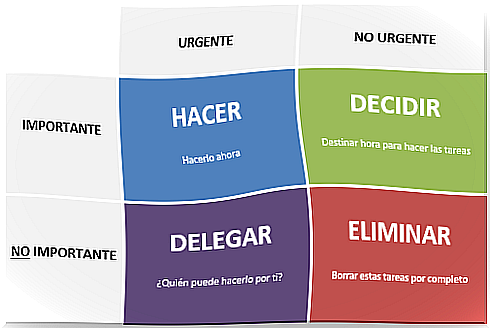Stephen Covey’s 4 Quadrants For Managing Time

Managing time well is not making a list of activities and then crossing them off as they are completed. It is knowing how to plan, prioritize, take advantage and of course, also discard. There is a method that helps to truly reach time for everything and that, in addition, teaches us to identify what we should spend time on and what not: Stephen Covey’s 4 quadrants for managing time.
Covey himself points out that time management is not limited to simply organizing tasks. He assures that it is a true philosophy of life. And it is because our well-being also depends on how we manage time.
Stephen Covey’s 4 Quadrants
The Stephen Covey Quadrants are simply a matrix, a model made up of four sections. Each of them represents a certain priority category in the tasks. At the same time, each quadrant includes a set of activities that must be managed differently. Let’s look at this in more detail.
The First of Stephen Covey’s Quadrants
Let’s imagine a cross. When you draw it, four empty spaces appear. Each of them is each of Stephen Covey’s quadrants. At the top left is the first of these quadrants. It corresponds to everything that meets two characteristics: urgent and important.

In this space are located all those tasks that cannot, nor should, be postponed, under any circumstances. It is the really priority, that which is more relevant than the rest. It demands that it be taken care of right now and that any other activity be put aside , until this is resolved.
In this quadrant situations are located, such as, for example, a failure in the electricity of the house. Many things depend on this, so it cannot be postponed. There also fit situations such as illness , a domestic accident, etc.
The second quadrant: what is not urgent, but important
The second of Stephen Covey’s quadrants corresponds to what should not be addressed immediately, but is of great importance. In other words, the important is not urgent. These are activities that are not decisive in the short term, but are decisive in the medium and long term.
In this quadrant are all those tasks that are not life or death, but are decisive for the quality of life or well-being. The first one is health. Everything depends on health and it is important to take care of it. The effects of not doing so are only seen in the long term and can be devastating.
In this space there are also tasks such as preparing for the final exams of a class, or maintaining a good relationship as a couple. Aspects such as training or updating of knowledge, etc. are included.
Stephen Covey’s Third Quadrant : Urgent Not Important
This is one of the most misleading Stephen Covey quadrants. Sometimes it is not easy to determine what are the activities and / or tasks that compose it. This is because the nature of urgency captures attention. However, even if it does, it is not something relevant in the background.

In this quadrant all those superfluous activities that are carried out by habit or chance could be located. For example, meeting someone and chattering for a while, not knowing exactly why. Or get involved in a discussion on social networks about some unimportant aspect. Another case would be a conversation on WhatsApp.
In either case, the greatest risk is in focusing on urgent activities that are not important, leaving out important activities that do not seem urgent. This is one of the main causes of time loss today.
The fourth quadrant: what is not urgent or important
The fourth of Stephen Covey’s quadrants is the one to locate all the useless. It is not of an emergency nature, nor is it of greater relevance. Still, these are activities that absorb part of our time.
Completely irrelevant actions such as checking email every five minutes are located in this quadrant. Or follow a conversation on social networks in which there is not even anything interesting to say. Also watch TV, talk and things like that.
Good time management
Most of those who draw Stephen Covey’s quadrant matrix, and attempt to apply it, find that the first quadrants to fill in are 1 and 3. That is, the urgently important and urgently unimportant quadrants.
Covey says this happens because people tend to think that everything is urgent. That sense of urgency is precisely what is at the base of stress. Thus, learning to manage these two spaces is what can help us improve our time management.

The author of this model recommends concentrating especially on Quadrant 2. He says that is where well-being and happiness are. If we can clearly identify what goes there and focus on it, Stephen Covey’s quadrant model will have done its job.
In conclusion, time is the most valuable and precious thing we have in our life. Therefore, we must know how to manage it, so that we know how to live life in the best possible way, taking advantage of every moment and being able to carry out our tasks and dreams.









